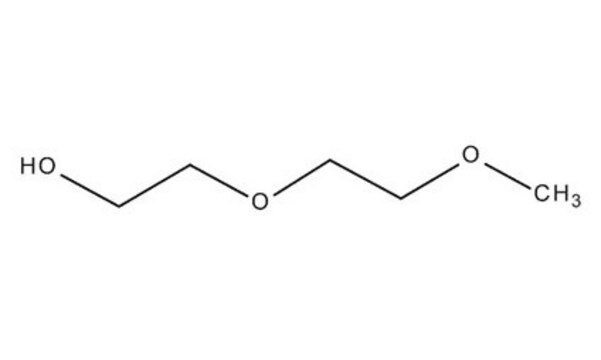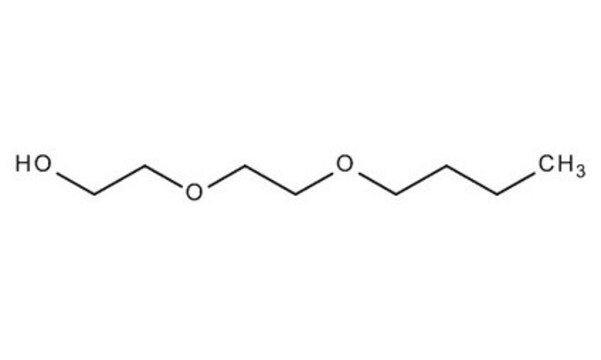8.03127
Diethylene glycol monoethyl ether
for synthesis
Synonyme(s) :
Diethylene glycol monoethyl ether, Carbitol, 2-(2-Ethoxyethoxy)-ethanol, Ethyl diglycol
About This Item
Produits recommandés
Pression de vapeur
0.13 hPa ( 20 °C)
Niveau de qualité
Pureté
≥98% (GC)
Forme
liquid
Température d'inflammation spontanée
204 °C
Puissance
5900-6100 mg/kg LD50, oral (Rat)
8476 mg/kg LD50, skin (Rabbit)
Limite d'explosivité
1.8-12.2 % (v/v)
Point d'ébullition
202 °C/1013 hPa
Pf
-78 °C
Température de transition
flash point 94 °C
Densité
0.99 g/cm3 at 20 °C
Température de stockage
2-30°C
InChI
1S/C6H14O3/c1-2-8-5-6-9-4-3-7/h7H,2-6H2,1H3
Clé InChI
XXJWXESWEXIICW-UHFFFAOYSA-N
Application
- Investigation of piroctone olamine delivery to the skin from single, binary and ternary solvent systems: This study explores the efficacy of diethylene glycol monoethyl ether as a solvent in dermatological applications, highlighting its role in enhancing skin absorption properties, which is crucial for cosmetic and pharmaceutical formulations (Tang CF, et al., 2023).
- Review of Pharmaceutical Applications of Diethylene Glycol Monoethyl Ether: This review comprehensively covers the pharmaceutical applications of diethylene glycol monoethyl ether, focusing on its solvent properties and roles in drug delivery systems, crucial for advancing drug formulation techniques (Hashemzadeh N, Jouyban A, 2022).
- Stepwise Access of Emissive Ir(III) Complexes Bearing a Multi-Dentate Heteroaromatic Chelate: Demonstrates the application of diethylene glycol monoethyl ether in the synthesis of luminescent materials, providing valuable insights for the development of optical and electronic devices in material science (Zheng Z, et al., 2022).
Remarque sur l'analyse
Density (d 20 °C/ 4 °C): 0.987 - 0.990
Water (K. F.): ≤ 0.20 %
Peroxide (as H₂O₂): ≤ 0.05 %
Identity (IR): passes test
Code de la classe de stockage
10 - Combustible liquids
Classe de danger pour l'eau (WGK)
WGK 1
Point d'éclair (°F)
204.8 °F - closed cup
Point d'éclair (°C)
96 °C - closed cup
Certificats d'analyse (COA)
Recherchez un Certificats d'analyse (COA) en saisissant le numéro de lot du produit. Les numéros de lot figurent sur l'étiquette du produit après les mots "Lot" ou "Batch".
Déjà en possession de ce produit ?
Retrouvez la documentation relative aux produits que vous avez récemment achetés dans la Bibliothèque de documents.
Les clients ont également consulté
Notre équipe de scientifiques dispose d'une expérience dans tous les secteurs de la recherche, notamment en sciences de la vie, science des matériaux, synthèse chimique, chromatographie, analyse et dans de nombreux autres domaines..
Contacter notre Service technique





